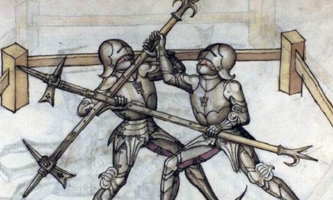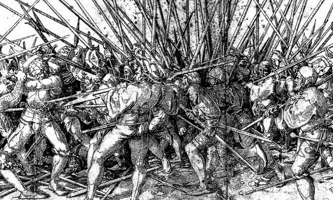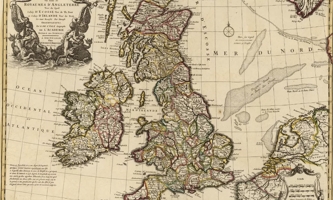Four in one

Spheres of War (SoW) is an umbrella for four traditional (non-computer) war games. Each game covers a 'sphere' of conflict, these being: Technical, Tactical, Strategical, and Political.
- Technical Sphere - management of single combatants within a duel, or a small skirmish where each combatant is controlled by a Player (RPG party). Detailed HEMA (Historical Western Martial Arts) based combat.
- Tactical Sphere - management of units within a battle; from skirmishing war-bands, to full armies. Also includes mechanised units such as tanks, aircraft, and ships (and sub-marines, inspired by the Western Approaches Tactical Unit (WATU), the Wren wargamers that help defeat the U-Boat menace).
- Strategic Sphere - managing armies within a campaign. Ideal for clubs; to use the Strategic sphere to organise Tactical games for other club players. Ancestor is Kriegsspiel.
- Political Sphere - War by other means, diplomats, spies, subterfuge - all to gain resources and allies.
The Spheres are interoperable, as they share a common core. This flexibility allows you to switch between Spheres or combine them as needed. For example, while playing a Tactical skirmish game, you could zoom into the action of an epic duel between leaders by switching to the Technical Sphere and resolve it using detailed single combat rules. You can combine Spheres to form hybrid games, such as joining the Technical and Political Spheres, to create a Role-Play Game.
Currently working on: Tactical Fragment 1
Organisational levels
I take the view that all the spheres are related at a fundamental level and have a similar conceptual base. Technique, as far as combat goes, is all about you. It's how you move your body, your footwork, how you punch, kick, block, parry, dodge, etc. It relates to training, your habits, and everything that goes into learning a skill until it becomes automatic. Practice makes perfect.
Tactics builds upon this but is a little more abstract and deals with units. In a unit, the leader acts as the brain that controls the whole unit, and the men in that unit are his 'limbs'. The unit is a 'body'. They can be referred to as a 'body of men'. How the unit moves (i.e. 'leapfrogging' using suppressive fire) is like it's footwork. You can think of a unit as a single multi-limbed monster!
This concept can be doubled up to include the whole army. Where an army is made up of units under the control of a single general. The general leading the army is now the brain, and all the units are his limbs. It's all the same fundamental concept, all derived from our perception of our body. Tactics includes everything that happens on the battlefield by moving men about in units. The important point is the leader, the general, is present on the battlefield. This changes with Strategy;
Strategy is even more abstract, and here the king is the brain, and the armies themselves are the limbs. In the modern world, this is the leader of the entire armed forces. Except at this level, we have to start including feeding the body, and that's 'logistics'. An important difference between Tactical and Strategical, is that in Tactical the leader is present on the field of battle, and with Strategy the leader is often not present on the battlefield. The leader interacts with the Tactical Sphere through operations (operational level of war, or operational art). Think of operations as the eyes and ears of the mega-monster that is the entire military forces of a country. Strategy needs information, it needs feedback, and as it's not on the battlefield itself, is needs reports, for them to be quickly processed, and handed to the decision-maker. Strategy cannot function if it cannot see or hear. If an army is cut off from Strategy, it resorts to Tactics, last orders, and standing orders. Last orders can be dangerous because the situation may have changed, and the army is effectively 'blind' to the bigger picture.
Politics is the most abstract of all, and with the supreme leader, it brings the loop full circle as it is above Strategy, but below Technique. The technique part is pronouncing words, to speak clearly, but the Strategy like part is controlling the entire armed forces and the civilian population, and organising everything to feed the army, and get goods into the logistics chain. It also controls the Grand Strategy of the armed forces, and decides the objectives. Politics makes 'limbs' out of everything. We may not like the idea, but we all use politics every day to maintain our alliances and organise. If you use words to organise, you are using politics. However, deep down, what most people seem to hate about politics, is not the idea of politics, but those who practice it on a political level. Those attempting to gain dominion over you, and you may not like 'leader'.
The reason speaking is below the Technical Sphere is because, in conflict; a punch in the face, or other physical violence, is more powerful than words. While words may work on your own side, they tend to have little effect on a determined enemy (and your words may have made them a determined enemy!). Words organise your side, not the other side, and has little effect on the other side. However, a well-organised army can have an effect on the other side, and beating them, or bringing them to a stalemate, may mean your words work once more. Words are subordinate to Action, but that does not mean words are not powerful, as they organise your side into a more effective military power. After conflict, they may also negotiate a lasting peace. For example; WWI ended in a bad negotiation, while WWII ended in a better negotiation.
Common Core
This covers elements that are common to all spheres, such as the M.A.R.S attribute system, the Autohit principle in combat, Stacked rolls, and the golden rule of averages.
[in development] Link
Technical Sphere
This Sphere is all about personal combat, and duelling, based on HEMA studies and gets into the ol' fight books of Talhoffer and modern re-creationists like The Arma. This Sphere is combined with the Political Sphere below to create the basis of the SoW Role-Play Game rule set. As mentioned above, it can also used when playing the Tactical Sphere games below to zoom into the clash of heroic champions in the midst of battle.

Single Combat
Each player controls a single combatant. Conflict is resolved using the common core Serial Match System, with the M.A.R.S. Dichotomy Attributes driving Actions and Reactions in D100 detail. This game allows you to explore the techniques, weapons and armour used during the middle-ages in context. All rooted in HEMA, and trying to create a ruleset that explains how combat actually works as a system.
[in development] Link
Tactical Sphere
This is a table top war game using miniatures using scales 6-28mm. It can handle small skirmisher warband games of a single unit aside, all the way up to great battles where the armies number in the hundreds and even thousands, thanks to the innovative scaling rules.

Table top battles
Spheres of War eschews the monolithic movement system of many table top wargames and takes a more chess like approach. I'm attempting to replicate simultaneous movement, by breaking down the conflict into bite-sized pieces; pairing opposing units into matches, and resolving these matches in series. Combat is quick, using 'stacked values', so you only have to role once per Action. Fast and bloody 🙂
This is a D10 game, a generalised version of the D100 Technical game above.
Strategical Sphere
War [campaign] management. It uses markers on a map and not miniatures. This is the game with the greatest scope. It can be played in its own right or used to organise game sessions for other Players in a club, who would use the other Spheres.

Core of the club
Using the Strategy Sphere, you could send an army, an envoy, or commandos to take a location or gain allies. If sending an army, the actual battle can be resolved quickly in the Strategy Sphere of handed off and fought in the Tactical Sphere (as a traditional campaign manager). If sending an envoy/ spies, again it can be resolved quickly in Strategy Sphere, or handed off to the Political Sphere and played as an RPG. If sending in commandos, it can be resolved quickly in the Strategy Sphere of handed off and Played in the Technical Sphere. Along with these, the Strategy Sphere supplied background and context for the mission within the Spheres, and takes into account many variables - production capacity, propaganda and other factors.
[in development] Link
Political Sphere
As Sun Tzu said: "politics is war without bloodshed and war is politics with bloodshed". The Political Sphere covers social interaction, managing alliances, political influence and power plays. When combined with Strategy is can run whole cities and states, where political manoeuvring has an effect of Strategy and can change the face of war. When combined with the Technical Sphere, it forms the basis of a role-playing game (RPG). The results of these RPG sessions can be fed back into the Strategy Sphere, giving access to new alliances, troops and funding.
[in development] Link
Club
Each sphere can be played in isolation from the others, or combined into a massive, sprawling, inter-connected game covering all aspects of war. (ideal for a gaming club).
Clubs: This interconnection makes it ideal of gaming clubs. The result of a game in one sphere can influence the games played within another sphere. This allows players of the Strategy Sphere to hand off battles to players of the Tactical Sphere, who can fight the actual battles and report back to their general. Zooming in on detailed, to cover pivotal moments, can be handled within the Tactical Sphere. Such pivotal moments could be duels between champions, or a battle commander handing over commando/ scouting missions to players of the Technical Sphere. Combining the Tactical and Political spheres produces a Role-Play Game (RPG). The results of RPG 'intrigue' sessions can affect Tactical and Strategy spheres.
Connect
If you liked this, and would like to leave a comment on my guestbook, or catch up on all the recent comments, please visit my connect page. While there, you can also subscribe to email notifications, so you never miss a new post, along with my RSS feed as a backup. If you are feeling generous, and I know times are hard, you may support my site through Patreon (exclusive behind the scenes content), PayPal or Bitcoin! Lastly, there is a confidential contact form for any secret messages you wish to pass to me. Thank you for reading, and I look forward to hearing what you have to say :)
